-Tate-Lucy-Green.jpg)
El Anatsui. Photo © Tate (Lucy Green).
by VERONICA SIMPSON
El Anatsui (b1944, Anyako) is not just Ghana’s most celebrated artist, but arguably the most prominent and successful African artist of his – or any - generation. He has just filled the Tate Modern’s Turbine Hall with three of his sculptures created from salvaged metal scraps, doing what he has become best known for – turning what some would call trash into treasure.
It is not the cheapness and ubiquity of his material that makes these pieces remarkable, but the extra layers of meaning and symbolism that he reveals through their construction and placement – not to mention the beauty he conjures from their shiny, lightweight surfaces.
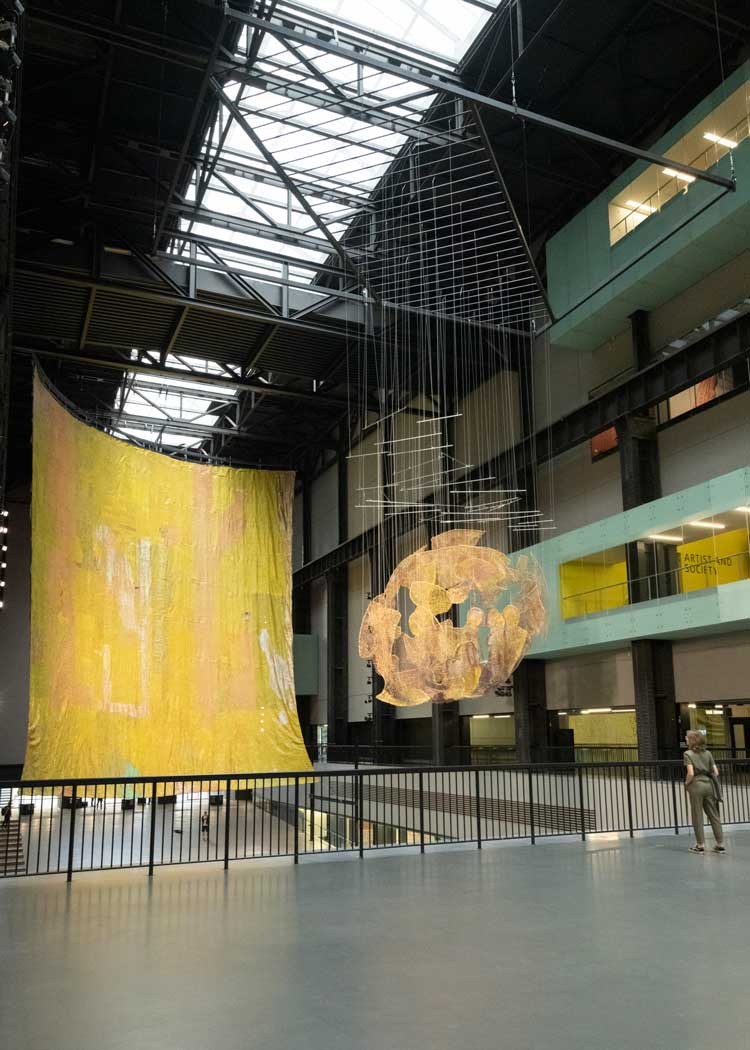
El Anatsui: Behind the Red Moon, installation view, Hyundai Commission, Tate Modern, London, 2023. Photo © Tate (Lucy Green).
His three pieces reference the Tate’s history – famously a brand whose wealth came from sugar plantations – while also evoking wider trade, dialogue and relationships between the UK and its colonies, then and now. But these works also achieve something near miraculous: they seem to bring a sense of movement into the huge, post-industrial concrete and metal hallway of the Turbine Hall. The glittering, crimson expanse of the first sculpture you encounter at the entrance (Act I: The Red Moon, 2023) billows towards you, as if in full sail. The other side, you find, is transformed into an expanse of gold metal, with watercolour hints of pink and turquoise, the better to act as a foil (pun intended) for the mobile sculpture (Act II: The World, 2023) that dangles near the Hall’s raised deck. From one side, it appears as a coherent orb, a moon or planet, but as you walk around it, the components come apart to reveal a collection of human shapes. Moving deeper into the hall, a great black, billowing wave emerges (Act III: The Wall, 2023) whose glossy, dark, collaged roof tiles reveal themselves to be flecked with patches of green, blue and gold, all visible in the waves that tumble at its base. Moving to the back of this draped sculpture, a far more uplifting expanse of silvery tiles is overlaid with a lace mesh of vibrant yellow and red. It is a heady and exhilarating experience simply to stare at the tiny quotidian details (the visible branding on folded foils) that make up this breathtaking mass.
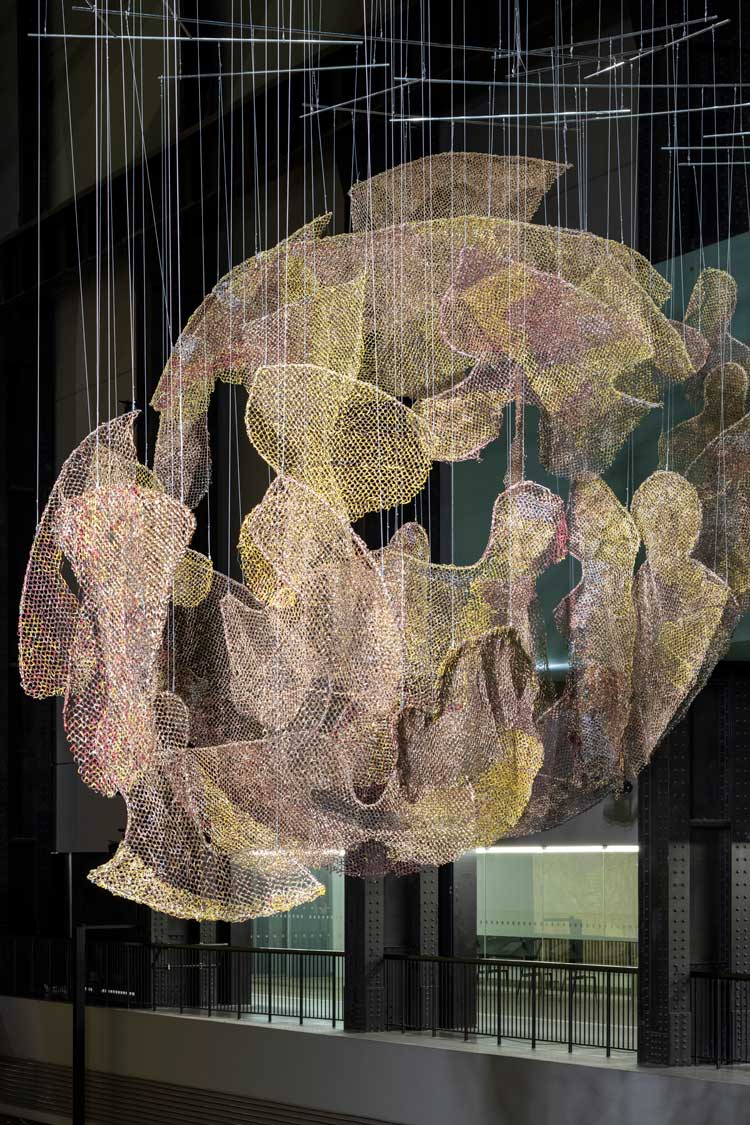
El Anatsui: Behind the Red Moon, installation view, Hyundai Commission, Tate Modern, London, 2023. Photo © Tate (Joe Humphrys).
Born and raised in Ghana, El Anatsui studied sculpture at Kwame Nkrumah University, but soon discarded the plaster-of-paris busts and borrowed tropes of its Eurocentric teaching for materials and subjects that felt more authentic and representative of his environment. Like many newly independent nations, Ghana wanted to establish a sense of its own identity. But where Kwame Nkrumah’s art department was still strongly affiliated to Europe, a new university, the University of Nigeria Nsukka, was creating its own syllabus. El Anatsui went to teach there, eventually becoming professor of sculpture, but always continuing with his own work. These included experiments with wood, scorched and marked with ancient African symbols, or slashed with chainsaws to evoke the violence of the colonial project and its erasure of people and traditions. He also made terracotta pieces from broken potsherds fired with manganese to look like archaeological relics.
It wasn’t long before he was enriching his vision of what art could and should be through residencies abroad, including Brazil and Namibia. A residency in Denmark resulted in a remarkable procession of freestanding sculptures made from driftwood he had sourced from a nearby beach, Akua’s Surviving Children, (1996).
The bottle-top works first appeared in Man’s Cloth and Woman’s Cloth, exhibited at the October Gallery in London in 2002, and were acquired by the British Museum. By 2007, his bottle-top pieces had joined the collections of de Young Museum in San Francisco, the Centre Pompidou and New York’s Metropolitan Museum of Art. He wowed the art world at the 2007 Venice Biennale with two monumental pieces hung in the Arsenale, Dusasa I and Dusasa II. A third piece was hung over the Palazzo Fortuny, triggering a new series of outdoor works, including one for the Royal Academy, and he was made an Academician in 2014. In 2019, he covered Munich’s Haus der Kunst’s 110-metre (360ft) facade in Second Wave, a textile made of shimmering metal printer’s plates.
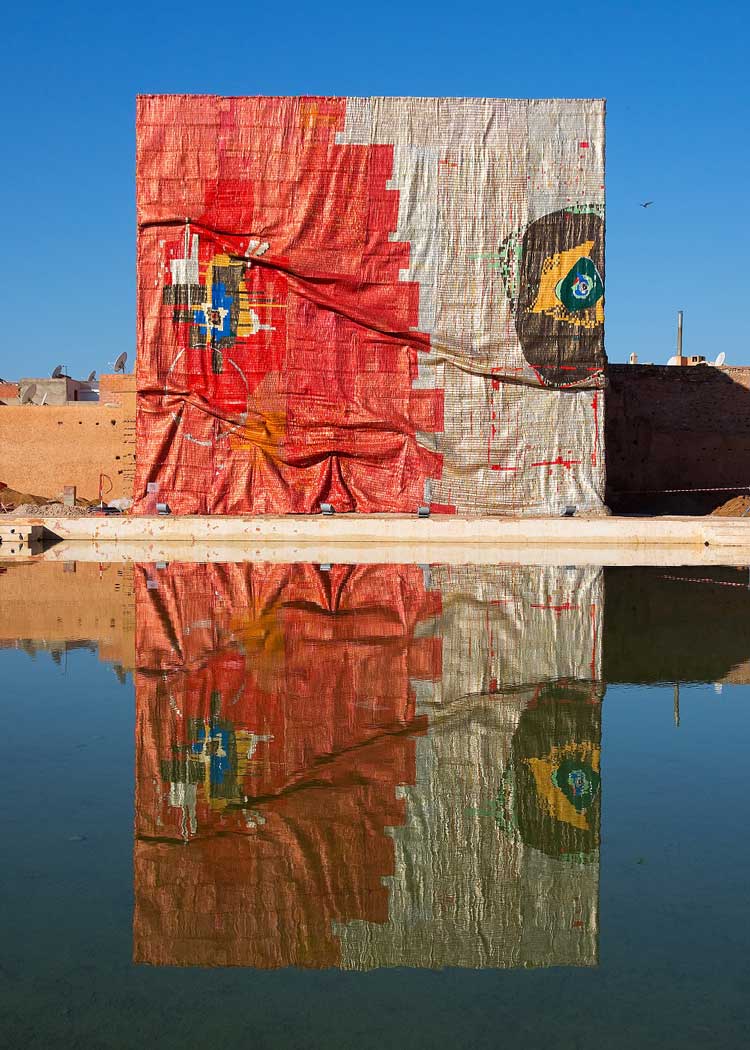
El Anatsui, Kindred Viewpoints, 2016. Aluminium and copper wire, 1680 x 2140 cm. Image courtesy Marrakech Biennale 6, NOT NEW NOW. Photo © Jens Martin.
According to the New Yorker, it was El Antasui himself who set the price for Dusasa I and II at $0.5m each. With that move, something significant in the market – and his profile - shifted. The New Yorker piece quotes Aigboje Aig-Imoukhuede, a Nigerian banker and art collector, who said El Anatsui was “the first Black artist based in Africa to have his works valued at an ‘international’ price standard. ‘Prior to him, there were always discounts.” His works now sell for millions.
He was awarded the Golden Lion for Lifetime Achievement in 2015. He is also the recipient of the Prince Claus Award (2009) and the Praemium Imperiale (2017). He is based in Nigeria and Ghana, and has recently built a much larger studio in Ghana so he can dream up glittering creations of even greater scale.
El Anatsui spoke to Studio International on the morning of the Tate Turbine Hall unveiling.
Veronica Simpson: This work in the Turbine Hall is spectacular. Congratulations! How did you conceive this response to the building, and what limits did the structure impose?
El Anatsui: You know, it has plenty of length and plenty of height. I didn’t quite take in the width, even though they sent me the plan of the place. I was trying to see the work in my mind and kept discovering that it was not an endless space in which you can do anything.
VS: You have dealt with huge structures and spaces before. I wish I had seen the Munich Haus der Kunst installation, but that was an exterior work. This is the biggest interior sculpture so far. When did the narratives emerge, the stories you are telling?
EA: I wanted to do something that would link with the space, and the Tate. Anyone who grew up in Ghana at the time I did knew that the only sugar we used was Tate & Lyle. It was many years after independence that I saw a different brand. With that in the background, I thought OK, what is Tate? That is sugar, it is sugar cane, which is labour, and labour is slavery, which means Africa and therefore we have this link between Europe, Africa and America.
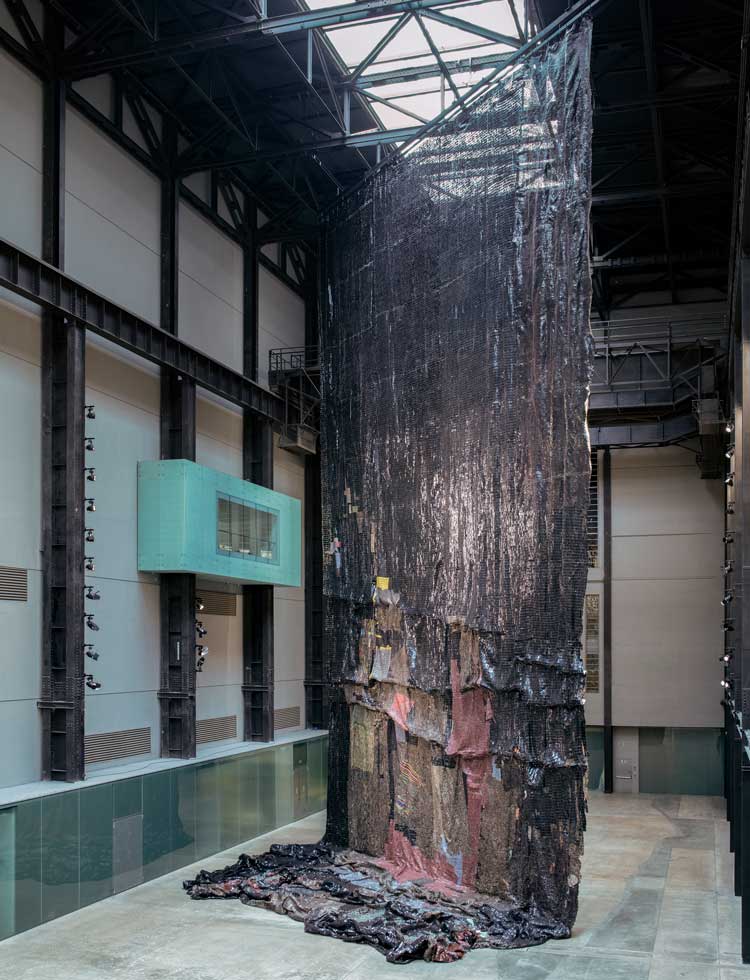
El Anatsui: Behind the Red Moon, installation view, Hyundai Commission, Tate Modern, London, 2023. Photo © Tate (Joe Humphrys).
The first idea was to lift a portion of one of the castles in Ghana (several fortifications were built by the British for containing and then despatching slaves), to reproduce that portion which has an underground dungeon and you climb some steps up into the chapel, and the chapel is directly on top of the dungeon. I thought that this was a very interesting scene of hell and heaven. I wanted to do a take on that, a reproduction. Then, after many trials, we discovered it wouldn’t fit. The height is OK, the length is OK, but the width is too narrow. And that took six months of trying to make it work. On the second visit here, I thought, OK this space is really, really narrow and it has the look of a ship. That’s how I came up with the idea of the sail. And the idea of working with sugar and all those things, they’re still there in the fact of using the bottle caps - because all the liquor is made with sugar.
VS: I love that sense of movement in the pieces, which draws people through the building and around the sculptures. They invite engagement, to make sure we see them from all angles - that dark sculpture at the back, in particular.
EA: You can think of that piece as either a wall or a wave. It looks like a sea or a wall, and it is a response to the sail in front. But then, in the middle, the sculpture is about mankind and how different cultures and people have continued to make the world and will continue to do so. There’s a lot of mixing around of people and cultures. Soon, it will be impossible to talk of someone as a pure breed of this or that. Already, more than 50% of people are mixed.
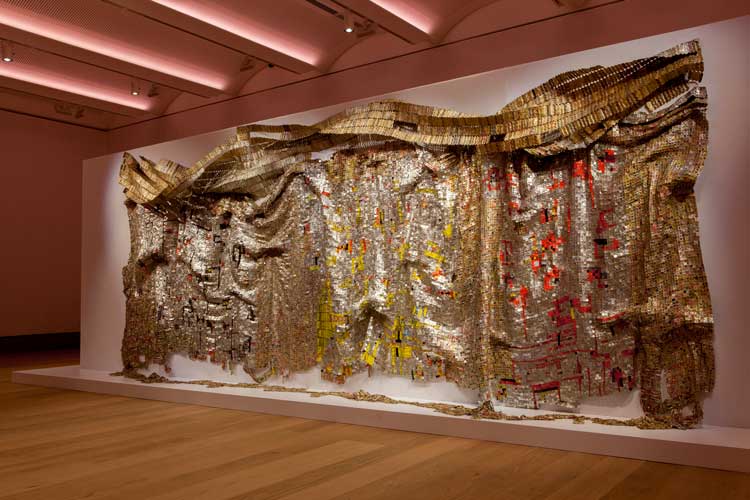
El Anatsui, Skylines?, 2008. Aluminium and copper wire, 300 x 825 cm. © El Anatsui. Private Collection. Courtesy the Artist and October Gallery, London. Photo © Jonathan Greet.
VS: I was fascinated to see how you would respond to the scale of this building. You have talked about wanting to be liberated from making work inside. You have said you would like to be like Christo and Jeanne-Claude, you would like more architectural and open-air interventions. Is there anything in the pipeline like that?
EA: Yes, I think so. Recently, I built a bigger studio than I’ve had so far. The Ghana studio is 80 metres (262ft) long and 40 metres across. And half of it is decked. With that kind of facility, the chances are that another work on a major scale will come. Also, if you consider that it’s an industrial area, it’s different from my Nigerian studio, which is not too far from the University of Nigeria Nsukka campus. The one in Ghana is right in the middle of industry. There’s a food processing factory to my left. They are huge buildings. I want to be in a place of making. We are all making. I am making art, and they are all making the orders they are doing. Getting to know the place more will impact on the kind of work that I do and even the materials that I engage with.
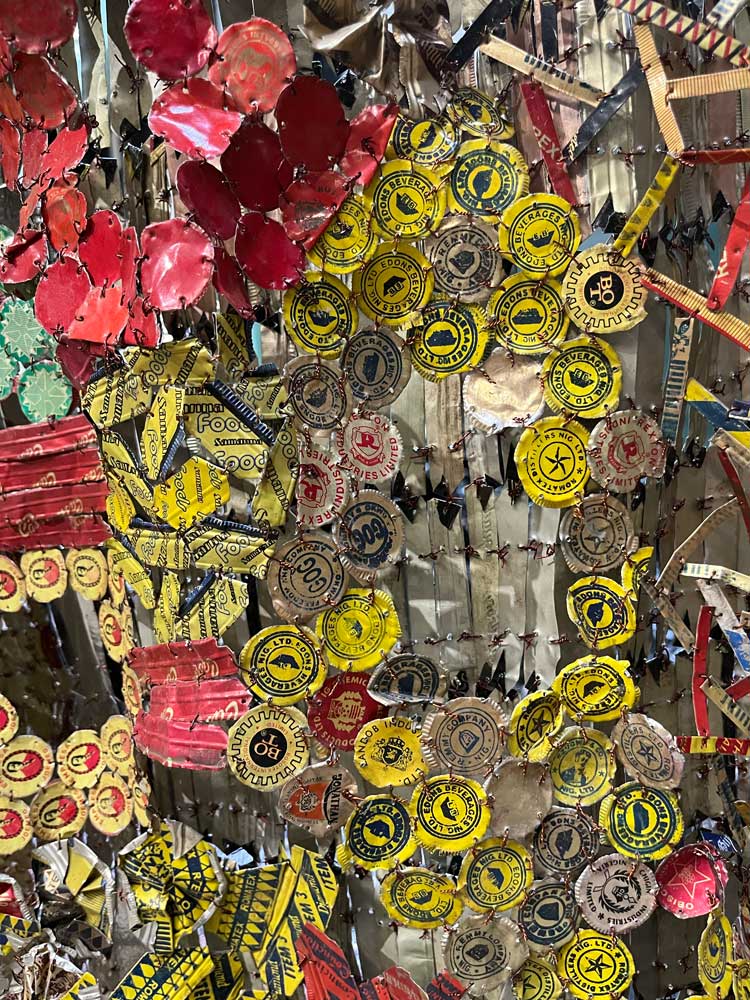
El Anatsui: Behind the Red Moon, installation view (detail), Hyundai Commission, Tate Modern, London, 2023. Photo: Veronica Simpson.
VS: I was intrigued to read that you left Ghana initially to teach in Nigeria because the University of Nigeria Nsukka had a radical programme not drawn from the west, not drawn from Europe.
EA: That’s right. In the first place I left Ghana because I was looking for adventure. I’d been in school with people from Nigeria and realised they had a different attitude to things, so when I got an appointment, I thought I’d go and see what makes these people tick. I discovered that they were also trying to rediscover themselves, like we were trying to do in Ghana. In fact, the whole of Africa, after independence, was getting to know who we are, what was to destroy, and what was left. Also, I arrived at the University of Nigeria Nsukka just after the civil war, and the scars of the war were still there – even in the campus. But after the war it had brought together a very deep concentration of the best brains from all over the country, and people who had been away came back home to remake their country. The faculty list when I went there was like a Who’s Who in any discipline – the sciences, the arts, everything. [The novelist and poet] Chinua Achebe was there. And so many other big names. And the likes of Uche Okeke, who spearheaded the movement to indigenise art, to look at indigenous culture and celebrate that.
VS: So, it was the best kind of art school. And I believe you were always urging your students to look to their surroundings for inspiration, not to Europe or America. In the last 10 years, there has been an amazing moment of discovery in the west with all the incredible talent coming from Ghana and Nigeria in particular. Many of them are your students. Do you feel satisfied with this shift?
EA: I think from this time of our insistence of having to look around and use what’s within them and from their environment, the talent is clear. When I saw the exhibition from our final year (degree show) it was so interesting and exciting that I decided for the first time to be a curator. We did a show called New Energy, in which I tried to bring together all the new forms of expression I’ve seen in students of painting, in sculpture, in ceramics, in all the areas. We had an exhibition in Lagos that was on for almost six months, and it was the talk of the town.
VS: I first saw one of your works in the Making Africa show at the Guggenheim Museum Bilbao in 2015. In that show a lot of the focus was on resilience and recycling. But your decision to use bottle tops was not about recycling.
EA: One of the ideas that we were always wanting to inculcate in our students is: you don’t have to go to the art shop to buy your materials, the materials are all around you. The tools are all around.
Bottle tops were not the first cheap material I worked with. I worked with milk bottle lids, and then cassava graters. I had picked up some bottle tops and kept them in the studio for months. One day, I cut the (foil) and opened it out and the top dropped. Then I wondered how to join things together – they didn’t lend themselves to that immediately. The foils did. But the bottle top, it is so small, what can we do? I started linking them together (with copper wire) and saw that it held. I kept expanding it. It has a new quality … I saw it as a continuation of that trajectory (I had established in wood and ceramics) of a form which is dynamic, a form that changes.
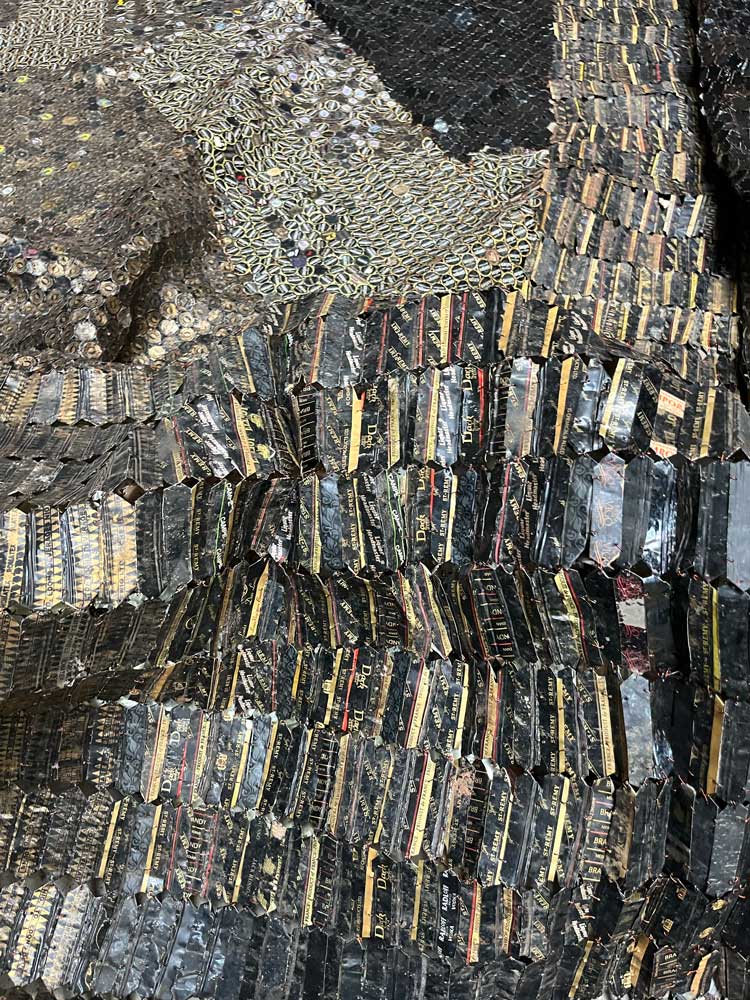
El Anatsui: Behind the Red Moon, installation view (detail), Hyundai Commission, Tate Modern, London, 2023. Photo: Veronica Simpson.
VS: There was a New Yorker article that said: “Nobody sees the same El Anatsui twice”, because you allow curators and galleries to rearrange these huge metal works as they see fit. But because you had moved through other materials to arrive at this stage, did you ever worry that you would lose interest? That these metal fragments would stop holding this power?
EA: Initially I thought it was going to be a short run. But as I kept working with this, it kept revealing new potential. Initially, I worked with the (foil around the) shaft and the round parts and then, after some time, I saw that there were rings around the neck of the bottle. I had lots of them, bags and bags of them. I managed to interlace them, put them together and because they are open and therefore transparent, that’s where the idea of the transparency came to me – that transparent membrane that we try to stretch. We haven’t found its full potential yet. There are new things I can do with that.
I say that the bottle caps have all the potentials of oil colour, acrylics and water colours, transparent washes of water colours, are possible with these materiais, depending on how you are combining them.
VS: How does that work as a process? Do you lay the materials out in colour sections, like a painter’s palette, so you can say I need more of those gold tops there and I need more of these green?
EA: With Man Cloth and Woman Cloth, I didn’t think about colour. They’re in the British Museum. You look behind them and you see all the colours are there. I was only thinking about sculpture. Then it dawned on me: “No, these things have colour.” I started looking at the colours more than form.
VS: How do you piece these huge constructions together? How do you direct the sections as well as the bigger construction?
EA: You can decide that some assistants can work with green for some time. And then work with other things. Then you tell them mix this and this.
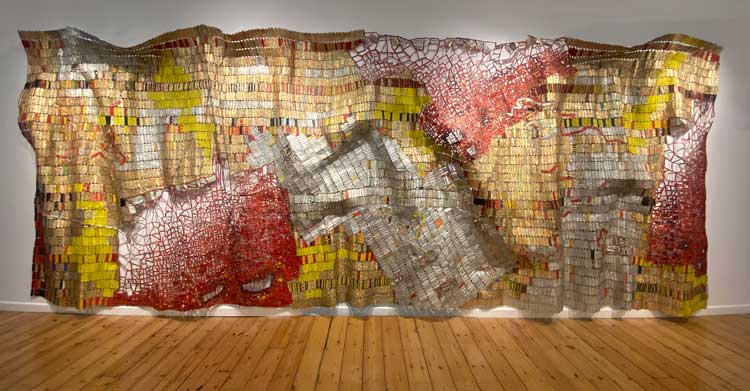
El Anatsui, Three sightings, 2021. Aluminium and copper wire, 280 x 807 cm. © El Anatsui. Courtesy the Artist and October Gallery, London. Photo © Jonathan Greet.
VS: Sometimes you have huge teams. I read that you had 150 people working on the Munich installation, some in the studio, some working at home. And that collaboration is also part of the spirit of the piece. You said you wanted it to be obvious that this is the work of many people.
EA: It affects the energy. If it was one hand only, you wouldn’t see that energy. You see different touches that are inbuilt there, and you feel the presence of more than one hand.
VS: Are you like a conductor with an orchestra? You have your chosen musicians in different positions, and you are guiding them?
EA: (laughs) Yes, exactly, like a conductor.
VS: I would love to talk to you also about value. I was reading in the New Yorker that you were the first to say that you wanted a certain amount for your work, and it was because you felt your work should be seen as of equal value. Where did that impulse come from, and your courage in sticking to your guns?
EA: I think that there is this profiling that goes on in almost everything, not only art, but everything. And this idea of trying to denigrate things because they come from a particular place also has something to do with who is collecting. If the catchment area of the collector is Europe, then certainly they will pay more for European art than art from Africa or Asia. But art is art anywhere in the world.
VS: What inspires you in your making? I know you have a garden and you love music.
EA: I do listen to music, but I don’t want to listen to it when I’m working. I don’t want music in the studio. If my assistants want it, they have to turn it to a level that only they can hear. I don’t want the attention span to be broken. You have to have a period of quiet where you can concentrate on what you are doing.
VS: So where does inspiration come from?
EA: From anywhere. It’s an endless source. From everything. From nature, from man-made things, from music, piles of rubbish. Oh yes. Things that people have used, and there are so many endless, endless delights. I asked students to list materials that are important for sculpture. And my favourite was a reply: all matter. In any form, in liquid form, in gas form and in solid form.
• El Anatsui: Behind the Red Moon is at the Turbine Hall, Tate Modern, until 14 April 2024.